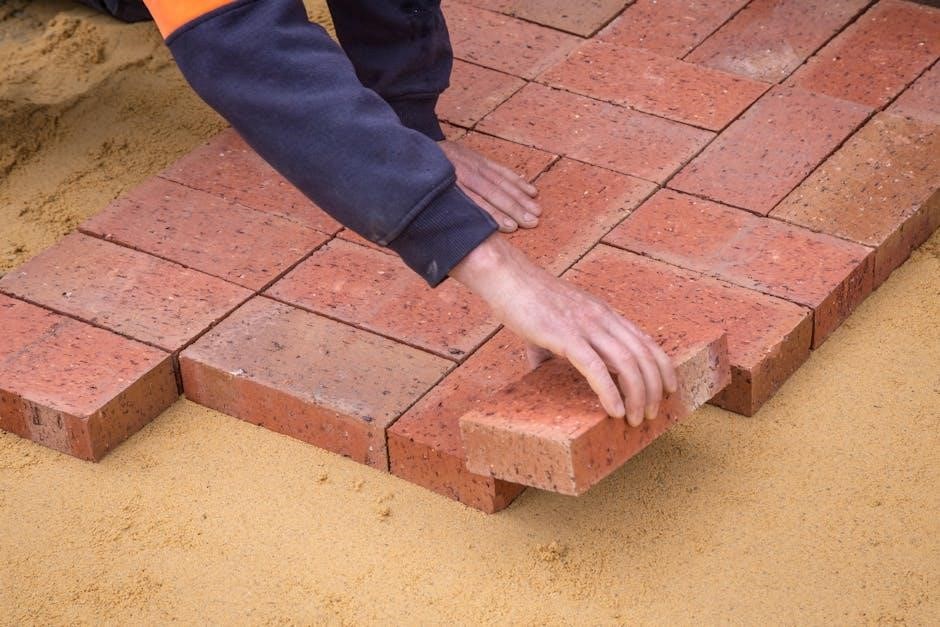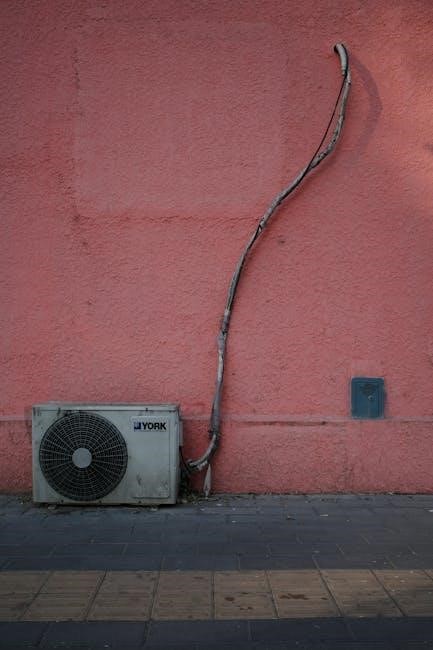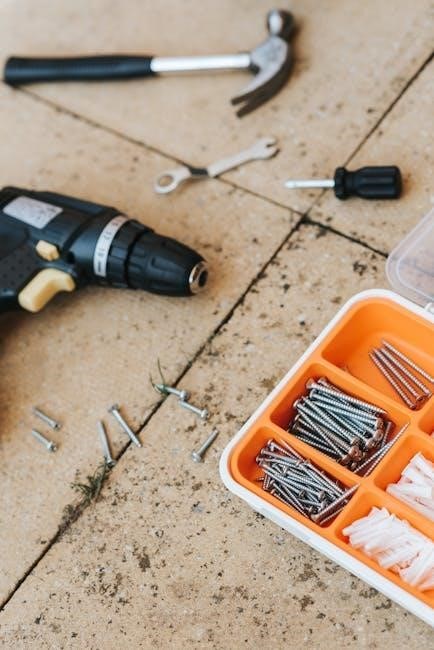Welcome to the Honeywell TH5220D1029 Installer Manual. This guide provides essential installation‚ programming‚ and maintenance instructions for the FocusPRO 5000 Non-Programmable Digital Thermostat‚ ensuring optimal system performance and efficiency.

Understanding the Manual Structure
This manual is organized into clear sections to guide installers through the setup and operation of the Honeywell TH5220D1029 thermostat. It begins with an introduction‚ followed by detailed explanations of system compatibility‚ installation steps‚ and programming options. The manual also includes troubleshooting guides and maintenance tips to ensure long-term functionality. Each chapter is divided into sub-sections‚ such as pre-installation checks‚ wiring instructions‚ and advanced configuration settings‚ making it easy to navigate. Key topics like electrical requirements‚ supported system types‚ and error codes are highlighted for quick reference. The structure ensures that installers can efficiently locate the information they need‚ whether they are setting up the thermostat for the first time or resolving operational issues. By following the manual’s logical flow‚ professionals can ensure a smooth and successful installation process. This clear organization helps minimize errors and maximizes system performance.

System Compatibility and Requirements
The Honeywell TH5220D1029 is compatible with 24 VAC single-stage and multi-stage systems‚ including gas‚ oil‚ electric‚ and heat pumps. It supports up to 2 heat/2 cool stages and operates with 750 mV heating systems‚ ensuring versatile installation options.
3.1 Supported System Types
The Honeywell TH5220D1029 supports various heating and cooling systems‚ ensuring compatibility with common setups. It works with gas‚ oil‚ and electric heating systems‚ as well as air conditioning. The thermostat is also compatible with heat pumps‚ steam systems‚ and high-efficiency furnaces. Additionally‚ it supports warm air and hot water systems‚ making it a versatile option for different home configurations. Its ability to handle up to 2 heat stages and 2 cool stages allows for precise temperature control in multi-stage systems. This wide range of compatibility ensures that the TH5220D1029 can be installed in numerous environments‚ providing reliable performance across different heating and cooling requirements. Proper installation and configuration are essential to maximize its functionality and ensure optimal system operation.

3.2 Electrical Requirements
The Honeywell TH5220D1029 requires a 24 VAC power supply‚ ensuring compatibility with standard heating and cooling systems. It supports both single-stage and multi-stage systems‚ as well as 750 mV heating systems. The thermostat is designed to work with 18- to 22-gauge thermostat wire‚ and shielded cable is not necessary for installation. Proper wiring connections are critical to avoid damage and ensure reliable operation. A disconnect means for the power supply must be provided‚ as required by local electrical codes. The thermostat operates efficiently within these electrical parameters‚ providing precise temperature control. Always verify the system’s voltage and wiring compatibility before installation to prevent potential issues. Adhering to these electrical requirements ensures safe and optimal performance of the Honeywell TH5220D1029 thermostat.
3.3 Compatibility with Heating and Cooling Systems
The Honeywell TH5220D1029 thermostat is compatible with a wide range of heating and cooling systems‚ including gas‚ oil‚ and electric heat‚ as well as air conditioning systems. It supports both single-stage and multi-stage heating and cooling systems‚ making it versatile for various home configurations. The thermostat is also compatible with high-efficiency furnaces‚ heat pumps‚ and steam systems. It can handle up to 2 heat stages and 2 cool stages‚ providing precise temperature control. Additionally‚ it works seamlessly with warm air‚ hot water‚ and high-efficiency heating systems. This broad compatibility ensures that the Honeywell TH5220D1029 can be installed in most residential settings‚ offering reliable performance across different system types. Always verify system compatibility during installation to ensure optimal functionality and efficiency.

Installation Process
The Honeywell TH5220D1029 installation involves mounting the thermostat‚ connecting wires‚ and performing post-installation tests. Use 18-22 gauge thermostat wire and ensure proper power supply with a disconnect means.
4.1 Pre-Installation Checks
Before installing the Honeywell TH5220D1029‚ ensure compatibility with your heating and cooling system. Verify the system type (e.g.‚ gas‚ oil‚ electric‚ or heat pump) matches the thermostat’s specifications. Check electrical requirements‚ including proper voltage and wiring. Ensure the power supply is 24 VAC and a disconnect means is provided. Review wire specifications‚ using 18- to 22-gauge thermostat wire‚ and confirm no shielded cable is needed. Familiarize yourself with the installation manual to avoid errors. Ensure the thermostat’s location avoids direct sunlight and drafts. Confirm the system is turned off before starting the installation. These checks ensure a smooth and safe installation process‚ preventing potential issues later. Proper preparation is key to optimizing the thermostat’s performance and system efficiency. Always follow safety guidelines and manufacturer recommendations.
4.2 Mounting the Thermostat
Begin by removing the existing thermostat and ensuring the wall area is clean and dry. Carefully pull the wallplate away from the old thermostat to access the wiring. Mount the Honeywell TH5220D1029 thermostat by aligning the wallplate with the screw holes‚ ensuring it is level and secure. Use the provided screws to fasten the wallplate to the wall. Gently snap the thermostat onto the wallplate until it clicks into place. Ensure no wires are pinched or damaged during this process. For proper installation‚ the thermostat should be installed in a location with consistent temperature reading‚ avoiding direct sunlight or drafts. Handle the wires carefully to prevent damage. Once mounted‚ double-check that all connections are secure and the thermostat is properly seated. Refer to the wiring section for detailed connection instructions. This step ensures a stable and accurate temperature control system. Always follow the manufacturer’s guidelines for mounting to avoid errors. Regular maintenance‚ such as replacing batteries annually‚ will keep the thermostat functioning optimally. Proper mounting is essential for accurate temperature sensing and reliable operation. Ensure the thermostat is ready for wiring and configuration before proceeding to the next steps.
4.3 Wiring and Connections
Before wiring‚ ensure the power to the HVAC system is turned off. The Honeywell TH5220D1029 is compatible with 24 VAC single-stage and multi-stage heating and cooling systems. Use 18- to 22-gauge thermostat wire for connections. Shielded cable is not required. Connect the wires to the appropriate terminals on the thermostat‚ ensuring no wires are pinched or damaged. Refer to the wiring diagram in the manual for specific terminal assignments (R‚ W‚ Y‚ G‚ C‚ O/B). The R terminal connects to the power source‚ while W and Y control heating and cooling stages. The G terminal is for the fan‚ and C is for the common wire if required. Double-check all connections to avoid errors. Turn the power back on and test the system to ensure proper operation. Handle wires carefully to prevent damage. Proper wiring ensures accurate temperature control and system efficiency. Follow the manual’s guidelines for a safe and reliable installation.
4.4 Post-Installation Testing
After completing the installation‚ perform thorough testing to ensure the Honeywell TH5220D1029 operates correctly. Start by turning on the power and checking the display for proper illumination. Verify that all buttons and controls function as expected. Test the heating and cooling modes by switching between them and observing if the system responds accordingly. Check the fan operation in both manual and automatic settings. Ensure the thermostat’s temperature setpoints accurately trigger the HVAC system. Test the changeover valve if applicable‚ ensuring smooth transitions between heating and cooling. Verify that the system maintains the desired temperature within the specified range. Perform a full cycle test‚ including heat‚ cool‚ and fan-only modes‚ to ensure reliability. If any issues arise‚ consult the troubleshooting section or the wiring diagram to identify and resolve the problem. Proper testing ensures the system is safe‚ efficient‚ and ready for use. Always refer to the manual for specific testing procedures. This step is crucial for confirming the installation’s success and ensuring optimal system performance.
4.5 Final Installation Checks
After completing the installation‚ conduct a final inspection to ensure everything is correctly set up and functioning properly. Verify that the thermostat is securely mounted and the wiring is neat and properly connected. Check that all settings‚ such as the date‚ time‚ and temperature limits‚ are correctly configured. Ensure that the system type and changeover mode match the installed equipment. Test all modes (heat‚ cool‚ and fan) to confirm they operate smoothly. Review the installer settings to ensure they align with the system requirements. Make sure the display is clear and all buttons are responsive. Verify that the thermostat is properly powered and that no error codes are displayed. Finally‚ ensure that the user has been provided with basic operating instructions. This final check ensures the system is safe‚ efficient‚ and ready for everyday use.

Programming and Configuration
This section guides you through configuring the Honeywell TH5220D1029. Learn how to set up initial programming‚ adjust basic and advanced settings‚ and customize options for optimal system operation.
5.1 Initial Setup and Programming
Begin by ensuring the thermostat is properly powered and connected. The Honeywell TH5220D1029 is pre-programmed with default settings‚ but you may need to adjust them based on your system. Start by verifying the system type (heat/cool) and stage configuration. Set the temperature range to match your preferences‚ ensuring at least a 3-degree difference between heat and cool settings. Check the installer settings‚ such as Function 1 (System Type)‚ to ensure it aligns with your equipment. Review the battery settings and date/time configuration for accuracy. If necessary‚ enable features like automatic changeover or remote sensor compatibility. Save your changes to apply the settings. These steps ensure the thermostat operates efficiently and meets your specific needs. Refer to the manual for detailed instructions on each configuration option to optimize performance and functionality.
5.2 Basic Configuration Options
The Honeywell TH5220D1029 offers straightforward configuration options to tailor the thermostat to your system. Begin by selecting the system type (heat‚ cool‚ or heat pump) and stage of heating/cooling. Set the temperature differential to determine when the system cycles on/off. Choose between manual or automatic changeover modes for heat and cool operation. Adjust the temperature display to Fahrenheit or Celsius. Configure the date and time settings‚ and enable the backlight timer for screen illumination. Set the battery monitor to alert you when replacement is needed. These basic options ensure the thermostat operates efficiently and matches your system requirements. Refer to the manual for step-by-step instructions to customize these settings effectively. Proper configuration ensures optimal performance and aligns the thermostat with your specific heating and cooling needs.
5.3 Advanced Configuration Settings
The Honeywell TH5220D1029 allows for advanced configuration to fine-tune system performance. Adjust temperature limits to set minimum and maximum allowable temperatures for heating and cooling. Configure the fan operation to control when the fan runs (continuous‚ auto‚ or circulate modes). Set the cycle rate to optimize how frequently the system cycles on/off. Enable or disable features like auto-changeover and remote sensor operation. Customize the system’s response to temperature changes by adjusting the temperature differential and swing settings. Advanced settings also include controlling the compressor protection time and configuring the system for multi-stage heating and cooling. These options provide precise control over the thermostat’s behavior‚ ensuring it operates efficiently and aligns with your specific HVAC system requirements. Use these settings carefully‚ as they can significantly impact system performance and energy usage. Always refer to the manual for detailed instructions.
5.4 Installer Settings and Options
The Honeywell TH5220D1029 provides a range of installer-specific settings to customize system behavior. Access the installer menu to configure options like system type‚ heat/cool stages‚ and fan operation. Set the system type to match the installed equipment (e.g.‚ gas‚ oil‚ electric‚ or heat pump). Adjust the heat and cool stages (1 or 2 stages) to ensure compatibility with the HVAC system. Configure the fan mode (auto‚ on‚ or circulate) and set the fan cycle rate. Enable or disable features like compressor protection‚ which prevents short-cycling‚ and adjust the temperature differential for heating and cooling stages. Installer settings also allow you to enable or disable remote sensor operation and set the remote sensor type. These options provide flexibility for system customization‚ ensuring optimal performance and efficiency based on the specific installation requirements. Always refer to the manual for detailed instructions on accessing and adjusting these settings.
5.5 Programming for Different Modes
The Honeywell TH5220D1029 allows programming for various operating modes to suit different comfort and energy-saving preferences. Installers can configure settings for Heat‚ Cool‚ Off‚ and Auto modes. In Heat mode‚ the thermostat activates heating when the room temperature drops below the setpoint. Cool mode enables cooling when the temperature rises above the setpoint. Off mode disables both heating and cooling‚ while Auto mode automatically switches between heating and cooling based on the indoor temperature. The thermostat also supports manual or automatic changeover‚ which can be set during installation. Additionally‚ the temperature differential between heating and cooling must be at least 3 degrees to prevent short-cycling. Installer settings enable customization of these modes to match the system type and user preferences‚ ensuring efficient operation and comfort. Always refer to the manual for detailed steps on configuring these modes.

Maintenance and Troubleshooting
Regular maintenance ensures optimal performance. Replace batteries annually‚ clean the thermostat‚ and check wiring. Troubleshoot common issues like error codes or unresponsive displays using the manual’s guide for quick solutions.

6.1 Routine Maintenance Tasks
Regular maintenance is crucial for the Honeywell TH5220D1029 thermostat’s efficiency. Replace batteries annually to prevent power issues. Clean the display and internal components gently to ensure accurate temperature readings. Check wiring connections periodically to avoid malfunctions. Ensure the thermostat is free from dust and debris‚ which can affect performance. Refer to the manual for detailed cleaning instructions. Additionally‚ verify that the thermostat’s date and time are updated to maintain scheduling accuracy. For systems with air conditioning‚ ensure the outdoor temperature is above 50°F (10°C) when operating in cooling mode to prevent compressor damage. Routine checks help extend the product’s lifespan and maintain reliable operation.
6.2 Common Issues and Solutions
Common issues with the Honeywell TH5220D1029 thermostat include blank or dim displays‚ incorrect temperature readings‚ and system response delays. For a blank display‚ ensure the power supply is stable and batteries are replaced if necessary. If the temperature reading is inaccurate‚ recalibrate the thermostat by following the manual’s instructions. Delayed system responses may indicate loose wiring connections; inspect and tighten wires as needed. Additionally‚ ensure the thermostat is properly mounted and level to maintain accurate operation. For error codes‚ refer to the manual for specific solutions. If issues persist‚ restart the thermostat by removing and reinstalling the batteries. Regular maintenance‚ such as cleaning the display and checking connections‚ can prevent many of these problems. Always consult the manual for detailed troubleshooting steps to resolve issues effectively.
6.3 Error Codes and Their Meanings
The Honeywell TH5220D1029 thermostat displays error codes to indicate specific issues. Common error codes include E1‚ E2‚ and E3‚ which relate to temperature sensing or system operation. E1 typically signifies a temperature difference of more than 3°F (1.6°C) between the setpoint and actual temperature‚ while E2 indicates a sensor malfunction. E3 may appear if the thermostat detects a communication failure with the heating or cooling system. Refer to the manual for a comprehensive list of error codes and their definitions. To resolve these issues‚ ensure proper wiring connections‚ check sensor accuracy‚ and verify system compatibility. If errors persist‚ restart the thermostat by removing and reinstalling the batteries. Always consult the manual for detailed troubleshooting steps to address specific error conditions effectively and restore normal operation.
6.4 Resetting the Thermostat
Resetting the Honeywell TH5220D1029 thermostat can resolve various issues by restoring factory settings. To reset‚ remove the batteries for 10 seconds and reinstall them. This process clears temporary errors and reinitializes the system. If the issue persists‚ ensure the system type (heat/cool) matches the installer settings. Check wiring connections and verify compatibility with your HVAC system. For advanced resets‚ access the installer settings menu and select the “Reset” option. After resetting‚ the thermostat will revert to default settings‚ requiring you to reconfigure temperature and system preferences. Regular resets can help maintain optimal performance and address unexpected behavior. Always refer to the manual for detailed reset procedures tailored to your specific system configuration.

Disposal and Environmental Considerations
Proper disposal and recycling of the Honeywell TH5220D1029 thermostat are crucial. Contact local waste management for recycling options. Remove the wallplate carefully to avoid damage. Ensure environmentally responsible disposal to prevent harmful waste and promote sustainability.
7.1 Proper Disposal Methods
Proper disposal of the Honeywell TH5220D1029 thermostat is essential to minimize environmental impact. Begin by safely removing the thermostat from the wall‚ ensuring no damage occurs. Disconnect the wiring carefully and set aside for recycling if possible. Remove the batteries and dispose of them separately‚ following local regulations for hazardous waste. Contact your local waste management authority to inquire about designated facilities for electronic waste recycling. Avoid disposing of the thermostat in regular trash to prevent harmful materials from entering landfills. Recycle the wallplate and packaging materials whenever feasible. By adhering to these steps‚ you contribute to environmentally responsible disposal and promote sustainability. Always follow local guidelines for proper disposal methods.

7.2 Recycling Information
Recycling your Honeywell TH5220D1029 thermostat is a responsible way to reduce environmental impact. Many components‚ such as plastics‚ metals‚ and electronic circuitry‚ can be recycled. Contact local recycling centers or e-waste facilities to inquire about accepting thermostats. Prepare the device by removing batteries‚ wiring‚ and any additional components. Packaging materials‚ like the wallplate and box‚ can also be recycled. Honeywell encourages participation in recycling programs to promote sustainability. Check with local authorities for specific guidelines and drop-off locations. By recycling‚ you help conserve resources and reduce landfill waste. Ensure compliance with regional regulations for electronic waste disposal. Proper recycling supports environmental conservation and aligns with eco-friendly practices. Take advantage of community recycling initiatives to responsibly manage your thermostat at the end of its lifecycle.

